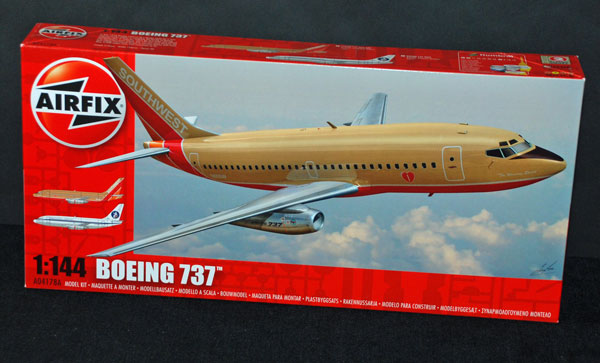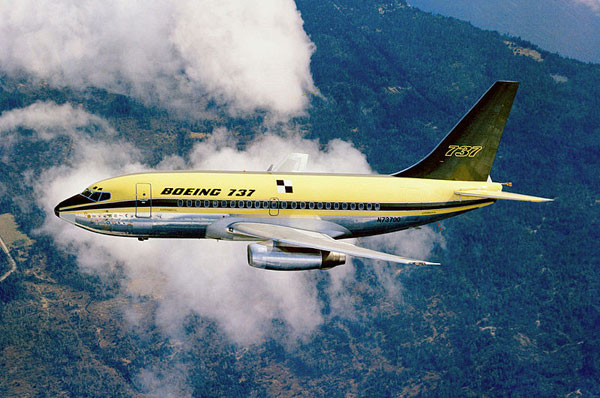
Ref: A04178A
Price around: 14.99 GBP (March 2014)
Review by Geoff Coughlin
Our thanks to Airfix for supplying our review sample. Get this kit here now at: www.airfix.com
Introduction
Two things before we get into this review – firstly, come on, who remembers building it first time around? I certainly do and the superb box art featuring that Lufthansa 737 with chrome-like natural metal undersides looked stunning. The build never had as much pleasure as the Boeing 727; I mean the 727 had working rear steps! That I am sure was all just personal taste. Now, both of these kits are now re-released after many years.
The second thing you may be wondering is why review what is essentially a civil airliner in SMN – a military magazine? Well, that’s because a number of air forces around the world have used the type over the years in all kinds of roles, so this Boeing 737 and the 727 that has also just been released are going into SMN.
A little bit about the Boeing 737

The Boeing 737 is a short- to medium-range twinjet narrow-body airliner. Originally developed as a shorter, lower-cost twin-engined airliner derived from Boeing’s 707 and 727, the 737 has developed into a family of nine passenger models with a capacity of 85 to 215 passengers. The 737 is Boeing’s only narrow-body airliner in production, with the -600, -700, -800, and -900ER variants currently being built. A re-engined and redesigned version, the 737 MAX, is set to debut in 2017.
Originally envisioned in 1964, the initial 737-100 flew in 1967 and entered airline service in February 1968. Next, the lengthened 737-200 entered service in April 1968. In the 1980s Boeing launched the -300, -400, and -500 models, subsequently referred to as the Boeing 737 Classic series. The 737 Classics added capacity and incorporated and CFM56 turbofan engines along with wing improvements.
In the 1990s Boeing introduced the 737 Next Generation with multiple changes including a redesigned wing, upgraded cockpit, and new interior. The 737 Next Generation comprises the four -600, -700, -800, and -900ER models, ranging from 102 ft (31.09 m) to 138 ft (42.06 m) in length. Boeing Business Jet versions of the 737 Next Generation are also produced.
The 737 series is the best-selling jet airliner in the history of aviation. The 737 has been continuously manufactured by Boeing since 1967 with 7,865 aircraft delivered and 3,680 orders yet to be fulfilled as of December 2013. 737 assembly is centred at the Boeing Renton Factory in Renton, Washington. Many 737s serve markets previously filled by 707, 727, 757, DC-9, and MD-80/MD-90 airliners, and the aircraft currently competes primarily with the Airbus A320 family. There are 1,250 Boeing 737s airborne at any given time on average, with two departing or landing somewhere every five seconds as of 2006.
Military Boeing 737’s
The initial model was the 737-100. It was launched in 1968. The -100 was rolled out on January 17, 1967 and entered service with Lufthansa in 1968. The aircraft is the smallest variant of the 737. Only 30 737-100s were ordered and delivered, and no 737-100s remain in service today. The original Boeing prototype, last operated by NASA and retired more than 30 years after its maiden flight, is on exhibit in the Museum of Flight in Seattle.
ineteen 737-200’s were used to train aircraft navigators for the U.S. Air Force, designated T-43. Some were modified into CT-43s, which are used to transport passengers, and one was modified as the NT-43A Radar Test Bed. The first was delivered on July 31, 1973 and the last on July 19, 1974. The Indonesian Air Force ordered three modified 737-200s, designated Boeing 737-2×9 Surveiller. They were used as Maritime reconnaissance (MPA)/transport aircraft, fitted with SLAMMAR (Side-looking Multi-mission Airborne Radar). The aircraft were delivered between May 1982 and October 1983
The 737-700C is a convertible version in which the seats can be removed from the aircraft to carry cargo. There is a large door on the left side of the aircraft. The US Navy was the launch customer for the 737-700C, designated C-40A Clipper by the U.S. military. The C-40B and C-40C are used by the US Air Force for transport of Generals and other senior leaders. The Boeing 737 AEW&C is a 737-700IGW roughly similar to the 737-700ER. This is an Airborne Early Warning and Control (AEW&C) version of the 737NG. Australia is the first customer (as Project Wedgetail), followed by Turkey and South Korea.